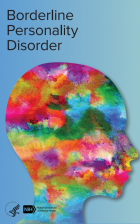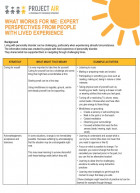Scam alert: Ads or websites claiming to have Medsafe approval or with the Medsafe logo are fake. Medsafe doesn’t endorse any health products, services or brands. Go to Medsafe for official information.
Borderline personality disorder (BPD)
Key points about borderline personality disorder
- Borderline personality disorder (BPD) is a mental health condition characterised by a pattern of varying and intense moods, an unstable sense of self and a negative self-image.
- People with BPD can use behaviours to reduce stress or punish themselves for what they believe they've done wrong as a way of coping. This may include self-harming or thoughts of suicide.
- Key symptoms include a fear of abandonment, unstable and intense relationships, intense and varied moods and impulsive behaviour.
- BPD often appears in teens or early adulthood. It can affect your relationships, work and wellbeing but can be managed with support and treatment.
- BPD is very treatable. Studies show 80 to 90% of people get better with treatment and some can get better without treatment.

Because each person experiences a different combination of symptoms, each person with BPD deals with different difficulties. You may experience some or all of the following symptoms (5 are needed for a formal diagnosis):
- Fear of abandonment (real or perceived) and trying to avoid it.
- Unstable and very intense relationships.
- Quick changes of mood, eg, feeling very happy then very sad in the same day.
- Inappropriate and intense anger.
- Doing things on impulse (not planning to do them or thinking about the consequences).
- Identity disturbance (not knowing who you are).
- Often having suicidal thoughts or behaviours.
- Feeling empty most of the time.
- Transient (passing) stress-related paranoid thoughts or dissociative symptoms (feeling like you're outside your body).
If your condition is more severe, you may have thoughts of self-harm or suicide. If you do, get help from your doctor or one of the helplines listed in the self-care and support section below.
Video: 9 Traits of Borderline Personality Disorder
This video may take a few moments to load.
(MedCircle, US, 2018)
The exact cause of BPD is unknown but many factors may play a role. Research suggests both genes and environment play a role.
For many people with BPD, their difficulties appear to be related to some of the following:
- A mismatch between your emotional needs when you were a child and what your parents or caregivers could give you.
- Social isolation or rejection during childhood (eg, being bullied)
- Experiencing traumatic events (eg sexual, physical or emotional abuse).
- Other frightening events happening in childhood which made you think people couldn't be trusted or were going to leave you alone – especially if you felt you had nowhere to turn to.
- Having a whānau member with BPD.
For other people, however, the cause is less clear.
If you have some of the symptoms mentioned above, it’s a good idea to see your doctor. They will ask you questions about your thoughts, feelings and behaviour, including sleeping and eating patterns, as well as how long you have been feeling this way. They will also ask if you have experienced these symptoms before and may ask about what's happening in your life at the moment. They may also do a physical examination and blood tests to rule out other causes for your symptoms.
Sometimes, it can be difficult to diagnose BPD because people with BPD may have symptoms that are similar to other mental health conditions or may have other mental health conditions at the same time. Your healthcare provider may refer you to a qualified mental health professional, who can do a more detailed assessment.
Treatment of BPD can involve a combination of psychological therapy, lifestyle changes and medicine, if needed. Psychological therapies are the treatment of choice for BPD. They may include individual, couple, family or group therapy. Examples of psychological therapies for BPD include:
- dialectical behaviour therapy (DBT)
- Structured Case Management
- cognitive behavioural therapy (CBT)
- mentalisation-based treatment (MBT)
- counselling or psychotherapy.
Medicines aren’t used as the main treatment for the illness. In some cases, a psychiatrist may recommend medicines to treat specific symptoms if they think you also have another mental health disorder, or for short-term stress relief.
For some people, alternative approaches (eg, mindfulness meditation, yoga and online courses) have been useful.
Self-care – what can I do?
Small steps are the key to change – choose what feels manageable and build from there. This can include:
- building your self-care skills – this builds your resilience so you can cope better with the challenges of life
- keeping physically active – this helps your mental wellbeing
- finding healthy ways to reduce and manage stress
- getting help when you need it – remember this is a sign of strength, not weakness
- staying connected to family, whānau and friends
- finding a purpose, which increases your sense of meaning and belonging.
Support
If you would like to talk to someone, see your healthcare provider or try one of the following free helplines:
- 1737(external link) phone or text 24/7 to reach a trained counsellor
- Lifeline (0800 543 354)
- Samaritans (0800 726 666)
- Youthline (0800 376 633).
Apps reviewed by Healthify
You may find it useful to look at some Mental health and wellbeing apps.
Borderline personality disorder(external link) Mental Health Foundation, NZ
Project Air(external link) Australia, resources for individuals and their families/carers Factsheets(external link)
Borderline personality disorder symptoms(external link) Psych Central
Borderline personality disorder(external link) National Institute of Mental Health, US
Spectrum – Specialising in Personality Disorder and Complex Trauma(external link) Australia
Apps
Mental health and wellbeing apps
Brochures
What works for me – expert perspectives from people with lived experience(external link) Project Air, Australia
What works for me – expert perspectives from people who support a person with personality disorder(external link) Project Air, Australia
What is borderline personality disorder?(external link) National Institute of Mental Health, US
Treatment and support for personality disorder(external link) Australian Government – National Mental Health Commission
A guide to talking therapies in NZ [PDF, 564 KB] Te Pou, NZ
He rongoā kei te kōrero – talking therapies for Māori(external link) Te Pou, NZ
Talking therapies for Asian people [PDF, 3.1 MB] Te Pou NZ
Talking therapies for Pasifika peoples [PDF, 3.1 MB] Te Pou NZ
References
1. Borderline personality disorder(external link) Mental Health Foundation, NZ
Emotionally unstable personality disorder(external link) PatientInfo Professional, UK, 2016
Choi-Kain LW, Finch EF, Masland SR, Jenkins JA, Unruh BT. What works in the treatment of Borderline Personality Disorder(external link) Curr Behav Neurosci Rep. 2017;4(1):21–30
Treatment guidelines for personality disorders(external link) Project Air – A Personality Disorders Strategy, Australia, 2015
Apps
Brochures

Borderline personality disorder NIH, US, 2022

What works for me – expert perspectives from people with lived experience
Project Air, Australia, 2020
Credits: Healthify editorial team. Healthify is brought to you by Health Navigator Charitable Trust.
Reviewed by: Dr Charlie Mentzel, Psychiatrist PhD, Dunedin
Last reviewed:





